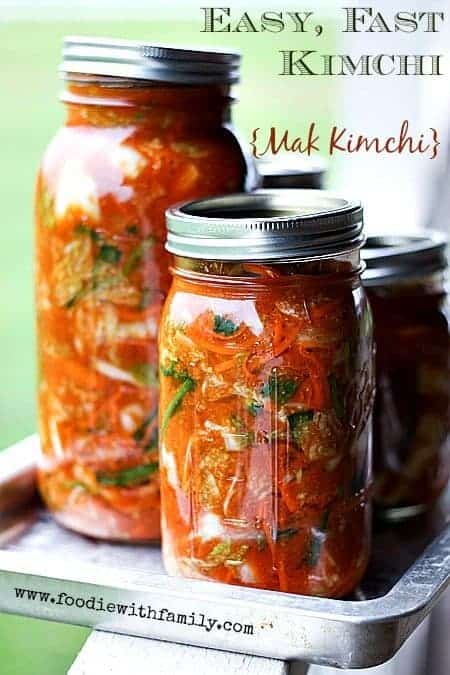
Love this Easy, Fast Mak Kimchi recipe? Check out our other fabulous Korean Food Recipes!
If you’ve been with me for a while, you’re well aware of my undying love for kimchi. Yes, it is stinky and bubbly and more than a little wild, but WOWZA the taste and the texture are so worth it.
If you’re new to the Foodie with Family family and you aren’t familiar with kimchi, I can give you a super condensed description; it’s essentially spicy, aromatic Korean sauerkraut. Today, I’m bringing you a fool-proof Easy Fast Kimchi recipe {Mak Kimchi}.
What is Kimchi?
Kimchi comes in almost as many forms as there are vegetables because nearly any vegetable can be fermented. They range from super mild smell to mega funky and mellow to melt-your-face-off spicy and there is one for every possible point in between.
The kimchi recipe that I’m sharing today is my family’s favourite version. It’s chock full of fabulous pro-biotics (as most kimchi is) and the longer it ages (translation: ferments) the stronger it becomes in both flavour AND pro-biotic content.
It’s like yogurt on steroids, people. That’s how good it is for you!
Is Kimchi Good For You?
Health Magazine named kimchi one of it’s Top 5 World’s Healthiest Foods. It is is low in calories and fat and high in dietary fiber and wicked high in Vitamins A, B, and C.
Many (if not most) Koreans eat a little kimchi with each meal or at least once a day. Kimchi is credited with helping most Koreans avoid obesity by virtue of its ability to satisfy even while being low calorie and low fat.
Seoul National University conducted a study and claimed that chickens infected with the H5N1 virus, also called avian flu, recovered after eating food containing the same cultured bacteria found in kimchi. That’s good enough for me!
How to Make Kimchi
Let’s get cracking and make some kimchi, shall we? The variety we’re making today is an Easy, Fast Kimchi recipe or Mak Kimchi…
In other words, it’s already cut up and ready to shovel into your mouth. Unlike what is usually just called ‘kimchi’ which is whole heads of napa cabbage smeared with the kimchi paste and allowed to ferment all wrapped up.
This version is FAR easier to make and far faster to be ready. Bonus, it is way easier to eat straight from the jar with a pair of chopsticks or a fork.
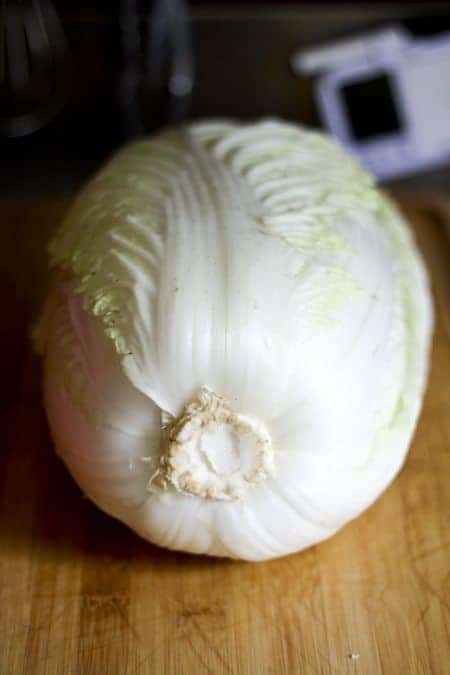
Do I need special tools to make kimchi?
In short, no. All you really need is a knife, a cutting board, and a big bowl. You will need a couple of ingredients that you may not have purchased before, but never fear, they’re not hard to find these days and I’ve included links to them below.
To begin with, you’ll need a big old head or two of Napa cabbage. I had two heads like the one above weighing in at about 3 pounds each.
It yielded, when all was said and done, about 3 quarts of kimchi, so that was perfect for me. You can cut that back if you think you can’t consume that amount of our Easy, Fast Kimchi recipe or Mak kimchi.
But I find all sorts of places to tuck it in, so it’s not an issue here and it’s only my husband, myself, and two of our boys who eat it. We love our kimchi.
Kimchi Recipe
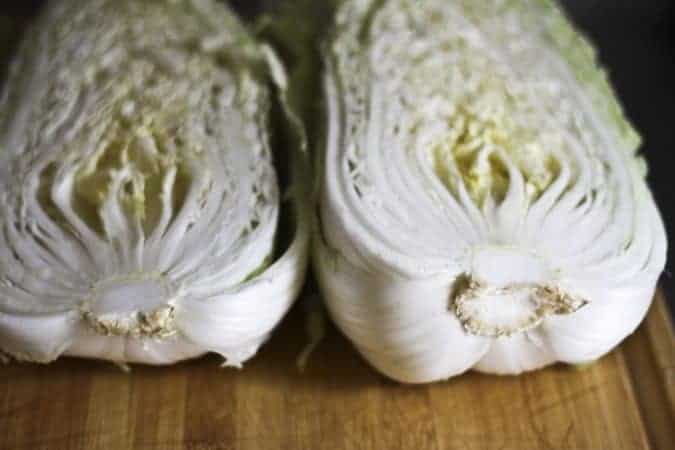
Lob your cabbages in half lengthwise. Use a paring knife to remove the gnarly core from them before cutting in half lengthwise again, leaving you with quarters.
Cut across the quarters to make bite-sized squares of cabbage. I usually shoot for 2-inch squares.
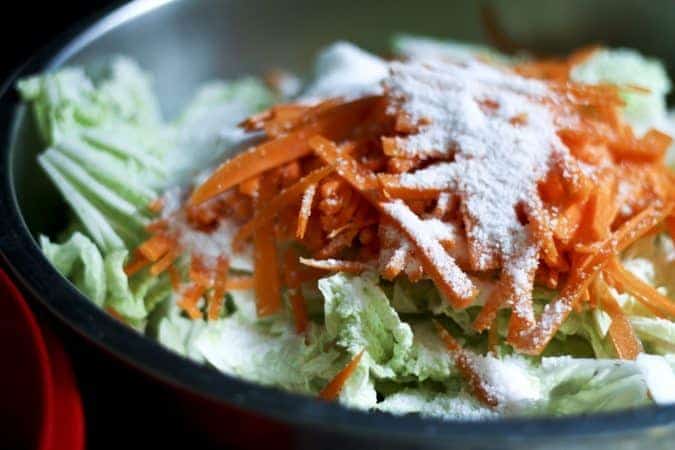
Add the cabbage to a monstrously huge bowl (or bowls), top with the julienned carrots, and sprinkle salt over the whole works. Toss the veggies and massage the mixture until the cabbage just starts to wilt.
Pour in enough cold water to over all the cabbage and carrots by a bit. It doesn’t have to be swimming in water, just covered.
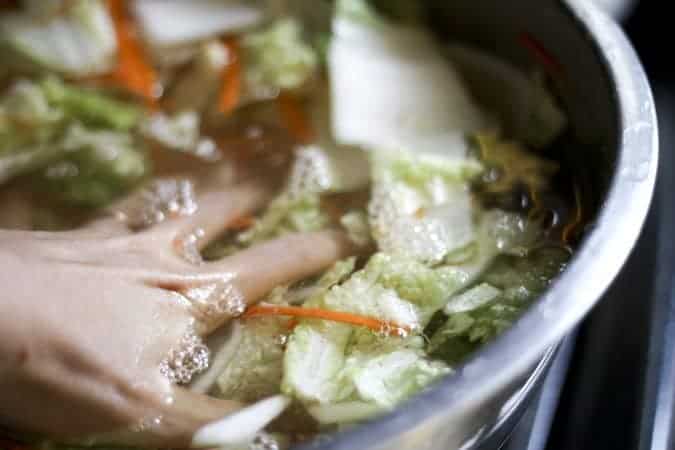
Stir it up with your hands and let it rest at room temp for a couple of hours.
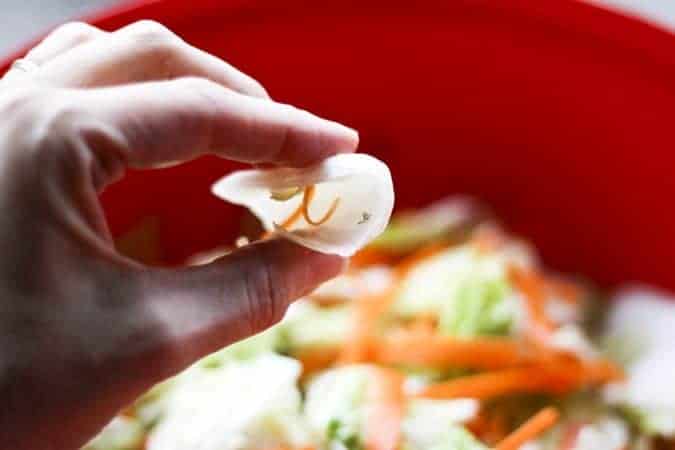
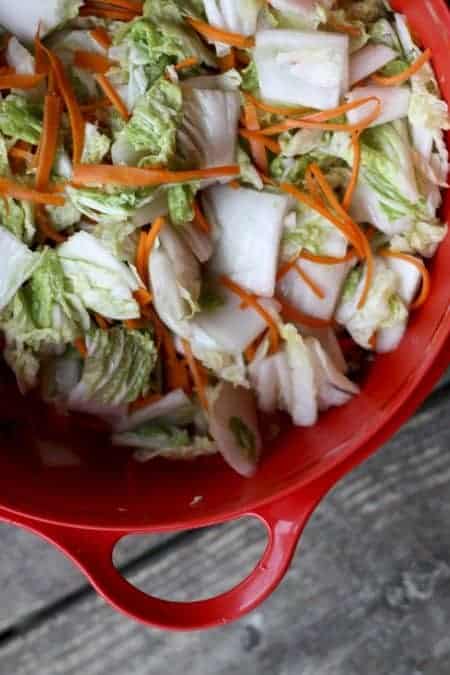
After a couple of hours, when the sturdier pieces of cabbage have become flexible, pour the whole lot into a strainer and let the brine water drain away.
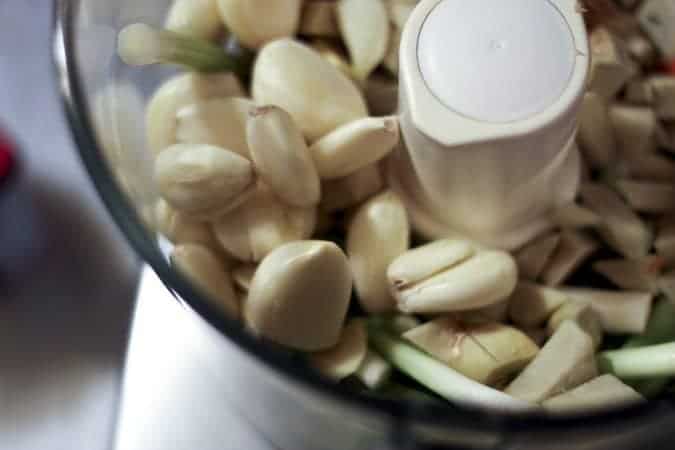
Now you’re going to whizz up the good stuff. Garlic, ginger, the white parts of scallions, Korean Red Pepper Powder*, fish sauce, unsweetened pear or apple juice, miso paste, and whatnot go into the food processor or blender.
Obliterate and smash it all into a lovely, red, fabulous smelling paste. It’s worth noting that you shouldn’t just up and increase the garlic because it can make kimchi linger more on your breath than you’d like it to do.
It also tastes out of balance if you add a lot more. Be aware.
And by the same token, you shouldn’t increase the ginger willy-nilly because that can make the final product a little more bitter than you’d like it to be. Start with the mixture and proportions I’m giving you and then play with it in subsequent batches.
*It’s important to note that you cannot use American or Mexican Chili Powder in place of the Korean pepper powder here. They’re COMPLETELY different animals. It may end up tasty, but I haven’t tested it so I cannot speak to it.
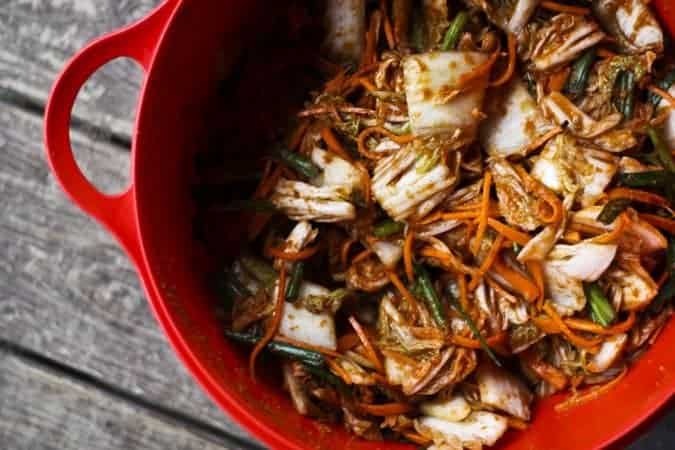
Now you’ll CRAM this stuff into jars or food-safe plastic containers. When I say cram it, I mean shove it in there as firmly as you can without putting your fist through the bottom of the jar.
I do prefer glass canning jars, if you’re wondering, because they don’t retain odors like plastic does, and, well, this stuff is odiferous! You can use a dedicated plastic kimchi bucket if you’d prefer, though.
Gently place a lid and ring on the jar, but don’t screw it tightly into place because BOOM. It’ll pop. This is active stuff, mes amies!
Place the jar on a rimmed pan or baking dish. The rim is pretty crucial here, because as the kimchi ferments at room temperature (and more slowly but still actively in the refrigerator) it will bubble up and may release a little juice over the edge of the jars.
In other words, you could have a kimchi river a-flowin’ on your counter top unless you take precautions. It’s easiest to use the pan and not worry about your Easy, Fast Kimchi recipe or Mak Kimchi bubbling over onto your counters.
It’s going to spend a couple of days at room temperature getting bubbly and fragrant. Every day, you’ll insert a clean chopstick or butter knife into the jar to help release air bubbles and top the jar off with extra brine if needed to keep everything submerged.
When it’s almost carbonated looking (usually between 24-72 hours after packing the jars), it’s ready to refrigerate. I highly recommend refrigerating it on the tray you used to contain the Grand Kimchi River while it fermented.
There aren’t a lot of things quite as unnecessary as removing everything from a fridge and mopping kimchi juices off of it. Take my word for it.
How long can I keep homemade kimchi?
It’s ready to eat at that point! Of course, it gets stronger and more kimchi-y the longer it sits. I love cooking with the older stuff and eating the newer stuff ‘raw’.
One of my all-time best-loved ways to eat older kimchi is in pancake form. Not like Aunt Jemima pancakes or flapjacks, but savoury, crispy-edged, kimchi-studded, pan-fried, snack cakes that convert even die-hard kimchi skeptics.
It’s the only way my eldest likes kimchi, but OH how he loves it this way. And the smell of kimchi pancakes while they cook is irresistible.
Bonus: This stuff lasts just about forever when you make sure the veggies are submerged in the brine. It’s hard to go wrong.
What can I make with my kimchi recipe? How do I use kimchi?
-Kimchi Fried Rice AND another version of Kimchi Fried Rice (the second one has a fried egg on top. SWOON!)
-Korean Army Stew- Budae Jjigae
-Kimchijeon (Savoury Kimchi Pancake)
Kimchi Ingredients
Kimchi
Cut the napa cabbage in half longways, then in half again longways. Cut the core out of the four quarters.
Cut the cabbage into squares (about 2-3 inches square), pop it in a bowl with the carrots. Sprinkle with the 1/2 cup kosher salt, massage so everything is coated in salt and starting to soften and wilt. Fill with cold, chlorine free water to cover it well and let it soak for at least 1 1/2 hours.
Pour the cabbage and carrots and liquid into a strainer. Let the brine drain away.
Lob off the white bits of the green onions and put them in a food processor with the garlic cloves, ginger, miso paste, and korean pepper powder. Zap it on high ’til it’s smooth-ish. Add in the fish sauce and a couple of slops of pear juice and zap it more until it’s about pancake batter consistency… maybe a bit thinner.
Put the brined cabbabe/carrots in a big, anti-reactive (glass, enamel, or stainless steel) bowl. Rough chop the green parts of the onions and add those to the cabbage/carrots. Pour the chili paste combo over the cabbage and wear gloves to massage it all over the cabbage/carrots green onions so everything is completely covered.
Pack super tight in canning jars. CRAM it in there.
Add a two-piece lid, but just set the ring in place to hold the lid down without screwing it in place. Place it on a rimmed baking dish to catch any spill-over.
Let it sit at room temperature for up to 72 hours, until it is bubbly and fragrant. Once every day, insert a clean chopstick or butter-knife to release air bubbles. If needed, pour in some additional brine to keep all the vegetables submerged.
Store on a rimmed sheet in the refrigerator for up to six months, being sure that the vegetables are submerged the whole time. The older it gets, the stronger it will become.
Notes
If you need extra brine to keep your vegetables submerged, please combine 1 quart of cool water with 4 teaspoons of kosher salt in a quart jar with a tight fitting lid and shake until the salt is dissolved. Use it to top off the vegetables as needed.
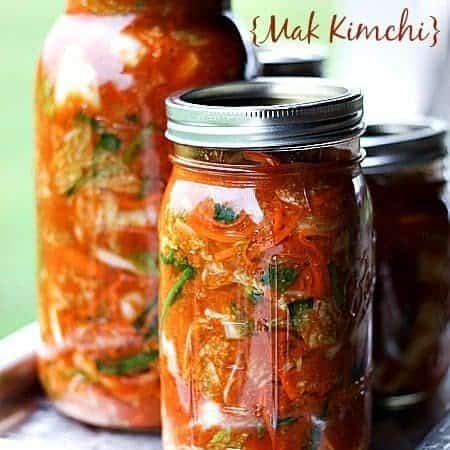
Easy, Fast Kimchi Recipe {Mak Kimchi}
Rate RecipeIngredients
- 3-8 pounds napa cabbage
- 2 bunches green onions trimmed of the root bits
- 2-3 large carrots peeled, thinly julienned
- 1/2 cup kosher salt
- 1/2 cup korean chili powder
- 15-20 cloves garlic overdoing garlic makes this stay on your breath more than usual., peeled
- 4-6 inches ginger peeled, rough chopped
- 1 tablespoon fish sauce
- unsweetened pear juice or unsweetened apple juice
- 4 tablespoons white miso paste
Instructions
- Cut the napa cabbage in half longways, then in half again longways. Cut the core out of the four quarters. Cut the cabbage into squares (about 2-3 inches square), pop it in a bowl with the carrots. Sprinkle with the 1/2 cup kosher salt, massage so everything is coated in salt and starting to soften and wilt. Fill with cold, chlorine free water to cover it well and let it soak for at least 1 1/2 hours.
- Pour the cabbage and carrots and liquid into a strainer. Let the brine drain away.
- Lob off the white bits of the green onions and put them in a food processor with the garlic cloves, ginger, miso paste, and korean pepper powder. Zap it on high ’til it’s smooth-ish. Add in the fish sauce and a couple of slops of pear juice and zap it more until it’s about pancake batter consistency… maybe a bit thinner.
- Put the brined cabbabe/carrots in a big, anti-reactive (glass, enamel, or stainless steel) bowl. Rough chop the green parts of the onions and add those to the cabbage/carrots. Pour the chili paste combo over the cabbage and wear gloves to massage it all over the cabbage/carrots green onions so everything is completely covered.
- Pack super tight in canning jars. CRAM it in there. Add a two-piece lid, but just set the ring in place to hold the lid down without screwing it in place. Place it on a rimmed baking dish to catch any spill-over. Let it sit at room temperature for up to 72 hours, until it is bubbly and fragrant. Once every day, insert a clean chopstick or butterknife to release air bubbles. If needed, pour in some additional brine to keep all the vegetables submerged.
- Store on a rimmed sheet in the refrigerator for up to six months, being sure that the vegetables are submerged the whole time. The older it gets, the stronger it will become.
Notes
Nutrition
Nutritional information is an estimate and provided to you as a courtesy. You should calculate the nutritional information with the actual ingredients used in your recipe using your preferred nutrition calculator.
did you make this recipe?
Make sure to tag @foodiewithfam on Instagram and #hashtag it #foodiewithfamily so I can check it out!
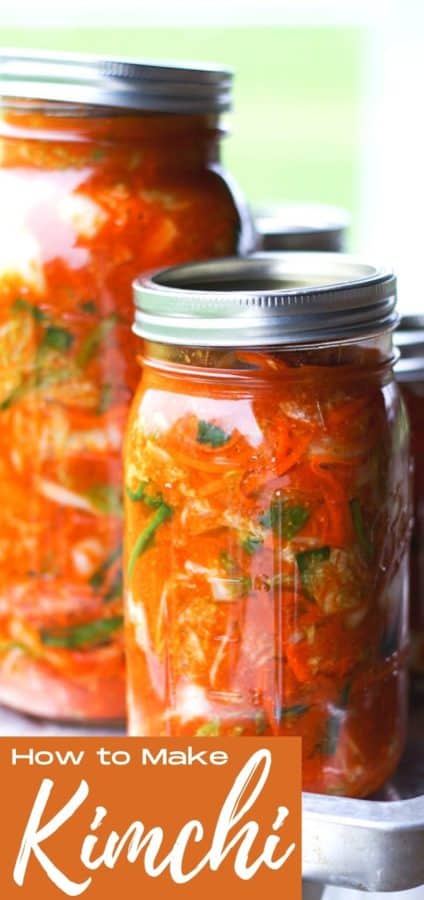
This post was originally published on December 2, 2013 and was updated December 28, 2016, June 2018, and September 2021.
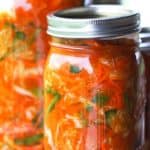



Reader's Thoughts...
Andrea says
Hello
How much apple juice should we add? I don’t see measurement
Rebecca says
Hi Andrea- There isn’t a hard and fast measurement, but about 1/4 cup should do it. 🙂 You’re basically looking to loosen up the paste enough to be able to smear it all over the Napa cabbage.
Lindsey says
I’m pretty sure we’re two peas in a pod! You also did the Claussen pickle knock off recipe too, right? Can’t wait to try this recipe too! I am vegan and also have some other food restrictions so I will have to make some adjustments, but I’m sure it’s going to be great too! Now that you know my tastes, please let me know if there are any other recipes you would recommend I try. Thank you!!! ❤️
Rebecca says
I sure did, Lindsey! Thanks so much for letting me know you love the recipe. I’d highly recommend you try my Chickpea Tikka Masala (already vegan!) and pick up my cookbook. My cookbook (Not Your Mama’s Canning Book) would be up your alley and as it is a canning book, there are very few recipes in there you’d need to alter. 🙂 Plus, you can check the recipe index for my vegetarian food section. Not everything in there is vegan, but should be pretty easy to alter! (Oh hey, and you should most definitely check out this cake.)
Taylor Zibell says
What a wonderful recipe I would love to try for my first Kimchi to try. I am just curious when you say add more brine to keep the veggies submerged while in the cans, is this the liquid you make above with the fish sauce unsweetened juice and miso paste?
Rebecca says
Hey Taylor! The brine is actually just salt mixed with water. Mix about 4 tablespoons of salt to a quart of water and stir until dissolved… Use that to top off the kimchi if necessary. Happy Kimchi-ing!
Jenvive says
Can I leave out the fish sauce as I react to it?
Rebecca says
I always advise leaving things out to which you react. It will, necessarily, change the end product, but it should still be tasty.
Mel says
Tried your Kimchi recipe yesterday and I must say WOW it is great even when just made. Had some straight away with my Asian noodle dish for dinner. I am anxious to taste it in a couple of days/weeks. Thanks for sharing.
Rebecca says
That’s just the best, Mel! Thanks for taking the time to let me know you love it! Enjoy!
Helen says
Can this be frozen? How high is the sodium content when it is ready to eat? IS the Koriean chili powder essential? There is no market near me that carries it. Thank you.
Rebecca says
Hi Helen- There’s no need to freeze it. The fermentation helps preserve it for quite a while! I have not tested the sodium content when it is ready to eat because I’m not a registered dietician or nutritionist. And the Korean chili powder is essential to this particular version of kimchi, which is the most common variety. You can order the chile powder from Amazon via the link I provided in the post. 🙂
ML says
This was THE BEST Kimchi I’ve ever tasted! I followed your recipe to a T – with one exception! I added celery and bok choy to the veggie mix. Everyone who has tasted it asks for a jar! Thanks for a wonderful recipe. We like to eat ours as a topping for ramen noodles. Delish!
Rebecca says
That sounds delicious, ML! Thanks for telling me the great additions you made to it and for the wonderful rating!
Gaye says
Hi, my husband has become allergic to capasian
So do you think it would work out try wasabi paste in place of it?
Thank you
Rebecca says
Hi Gaye- I’m afraid I have never tried wasabi in place of the red pepper flakes in kimchi, so I’m not sure what to advise you! I know there are some non-spicy white kimchis that are pretty traditional. Maybe you should try one of those!
Stephanie says
I made this on the weekend and it was so salty like eating preserved vegetables. Did I do something wrong? 🙁
Rebecca says
Hi Stephanie- Can I ask what type and brand of salt you used when you first salted the cabbage and carrot mixture?
Suzanne says
This tasted amazing the first day I’m thinking I should have refrigerated after 24 because now after 48 hrs the flavor isn’t very pleasant. Would you recommend refrigerating now or at 72 hours. My hope is allowing more ferment would make more sour/ pleasant but I don’t want it to get more gross lol. The recipe is amazing btw I’m just trying to get my fermentation timing right.
Rebecca says
Hi Suzanne- Play around with it a bit. If you’re down with it, I would stash half in the refrigerator and leave half out to see which I preferred for the next go round. Because every kitchen is different, fermentation occurs at different rates everywhere. It’s an art as much as a process. If you end up with pretty powerful kimchi, you can still use it and tame it a bit by stir-frying it!
Alba says
Hi, I just had a question, because i think i made a huge mistake.
My kimchi has been almost 72h fermenting and It was perfect, except for one thing, I thought It was a little bit dry and i had the ” great” idea of putting back some of the juices that overflowed from the jar… The I realized that maybe It wasn’t a good idea, and I don’t know if I just messed up a delicious badge of wonderful kimchi.
I took the juices out, and left the kimchi to see if makes bubbles again. MY KIMCHI! I’M PANICKING.
Rebecca says
Hi Alba- I don’t think you need to panic. Just keep an eye on it. If you had added something odd to it, I might worry otherwise. 🙂
Bekki says
Goma woyo! Glad to have this recipe for Mak Kimchi. Last night, I used all the suggested ingredients but added a few yellow and red sweet peppers. Now, I’m just waiting for the bubbly action to start…LOL! Looking forward to eating this homemade kimchi in the next few days and onward. 🙂 Also, I must be Korean “at heart” because this morning the two jars (I cut the recipe in half) of spicy fermenting brew in my kitchen smells really good!
Anne says
I am making this now. THANK YOU! Question. You say to lob of the white parts of green onions and put “them” in the food processor. Does “them” refer to the white parts or the rest of the onion after the white is gone.
Rebecca says
Hi Anne- I hope this gets to you in time, but if it doesn’t, it isn’t a disaster. Yes, I whiz up the white bits in the food processor.
Mary Hill says
I have never tried this, therefore, I would like to try it, before I try to make it. So what’s the best brand to try to get the real taste of it?
Thanks Mary
Rebecca says
Hi Mary! There are quite a few good brands in stores these days. Primarily, I’d go for any of them that are Korean brands. Make sure you get one that is a good, deep-red coloured one. There is a widely available brand named “Mother-In-Law’s Kimchi” which is pretty good flavourwise, but tends to be a little mild for me.
Josh says
Hi! Are you sure about the 1/2 cup of Korean chili powder? I made this exactly according to the recipe and looks great, but one bite and my mouth is on fire and my eyes are watering. Lol
Rebecca says
I am sure, Josh! If you like it milder, adjust accordingly!
Josh says
Thanks! I must be a wimp. Haha. Look forward to making again. Looks and smells great!
Diana says
So do you not reserve the brine water and pour over the top once you fill the jars? I don’t see anything about that but I’ve always added the water and the cabbage mix? I did see something about topping off with brine after it’s fermented a while so I wanted to make sure!
Rebecca says
You can definitely reserve that if you wish, or make a new brine to top it off; it’s your choice.
Matt says
Awesome stuff! I like how thoroughly you explained some of the finer details of kimchi…I love the stuff but never knew!
A few questions: I got all gung ho about making kimchi without first looking up a recipe…
I have some fresh hot chiles, can I use those in place of the chile powder? If the chile powder is left out, will that affect the recipe other than it not being spicy? And could I use another brand/type of chile powder instead?
I’ve never before seen unsweetened apple or pear juice…is there a way to substitute for that if I can’t find it in the grocery? Would diluting some ACV be feasible?
Thanks for the help!
If I could make one suggestion, I think placing a picture of the cabbage with the core removed directly after where you write about it could be helpful. I cook enough to have and idea of how deeply/what to cut out…it could be a bit confusing/ambiguous for someone new! Thanks again!
Rebecca says
Hi Matt- Thanks so much. Let me address your questions.
1) I have never made it with fresh peppers. I believe that using the dried Korean pepper powder is considered the standard recipe.
2) Many apple juices are sold unsweetened. I think Mott’s has a no-sugar added apple juice! Just check over the labels of juices that say 100% apple juice and you’ll be fine!
3) I would not advise using ACV.
Happy Kimchi-ing!
Kris says
Could you just use cucumbers in the place of the Napa cabbage?
Rebecca says
Hi Kris- I think that would be tasty for a quick kimchi, but I don’t think it would hold up structurally as well as the Napa cabbage for long term Kimchi-ing. 🙂
Alexandra says
Hi! I was wondering, if I don’t have any of the paste left over what should I use as a brine to top off my jars? Just salt water?
Rebecca says
Indeedy! Salt water will do the trick!
Bunny says
I just made a half recipe. It’s my first. I tasted the paste, and I could eat that on eggs, or even as a pizza sauce. Does this paste have a name?
I have 3 days before I get to eat this! I’ve never actually had kimchi before. I can’t wait!
Rebecca says
Hi Bunny- I don’t know if there’s a word for the paste, but it IS darned good, isn’t it?
Lauren says
it is called as gochujang in korea, i do not really know the meaning, but since the korean red pepper powder is galled gochugaru, perhaps the word “gochu” means korean red pepper and the word “jang” means paste